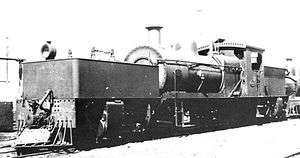WAGR G class
| WAGR G class | |||||||||||||||||||||||||||
|---|---|---|---|---|---|---|---|---|---|---|---|---|---|---|---|---|---|---|---|---|---|---|---|---|---|---|---|
.jpg) G233 Leschenault Lady at the Western Australian Rail Transport Museum | |||||||||||||||||||||||||||
| |||||||||||||||||||||||||||
| |||||||||||||||||||||||||||
| |||||||||||||||||||||||||||
| |||||||||||||||||||||||||||
The WAGR G class was a class of steam locomotives operated by the Western Australian Government Railways (WAGR) from 1889. The class's wheel arrangement varied; the first 24 were 2-6-0s and the last 24 4-6-0s.[1]
History
A total of 48 G class engines were acquired by the WAGR between 1889 and 1899, both new and second-hand. They were the first class of locomotives to be introduced to the WAGR network in quantity. They were part of what became almost an Australian 3 ft 6 in (1,067 mm) standard, as locomotives of similar design served in large numbers as the Silverton Tramway Y class, South Australian Railways Y class and Tasmanian Government Railways C class, and also in Queensland and on the Emu Bay Railway and North Australia Railway.[1][2]
They were designed by Beyer, Peacock & Co who built seven, with James Martin & Co building 29 and Neilson & Co 12.[3][2]
During World War II, 13 were loaned to the Commonwealth Railways for use on the North Australia Railway as their Nfc and Nga classes.[4][5] Others were sold for further use by timber mill operators in Western Australia while some saw further service with the Chillagoe Railway & Mining Co, Cairns. The class remained in service in significant numbers until the 1960s.[3][6]
Survivors
Several have been preserved:[6]
- G53: plinthed at Pemberton[7]
- G117: on display at Merredin station[8][9]
- G118: on display at Kalamunda station[10]
- G123: Koombana Queen preserved by the Hotham Valley Railway[11]
- G233: Leschenault Lady under restoration at the Western Australian Rail Transport Museum, previously operated services out of Bunbury in the 1970s, was overhauled by Midland Railway Workshops in 1999 and operated out of Kalgoorlie[5][12]
See also
References
Notes
- 1 2 Gunzburg 1984, p. 29.
- 1 2 Oberg, Leon (2010). Locomotives of Australia 1850s-2010. Dural: Rosenberg Publishing. pp. 66–71. ISBN 9781921719011.
- 1 2 Gunzburg 1984, pp. 30-34.
- ↑ Narrow Gauge NFA & NFC Chris' Commonwealth Railways Information
- 1 2 Clark, Peter (2012). The Australian Locomotive Guide. Dural: Rosenberg Publishing. p. 49. ISBN 9781922013682.
- 1 2 Whiteford, David; De Bruin, Charles; Watson, Lindsay; Watson, Neville (1983). Western Australian Preserved Locomotives. Elizabeth: Railmac Publications. p. 16. ISBN 0 949817 19 8.
- ↑ G53 Australian Steam
- ↑ G117 Australian Steam
- ↑ Merredin Railway Museum Australia's Golden Outback
- ↑ G118 Australian Steam
- ↑ G123 Hotham Valley Railway
- ↑ Federation Train Rail Heritage WA
Cited works
- Gunzburg, Adrian (1984). A History of WAGR Steam Locomotives. Perth: Australian Railway Historical Society (Western Australian Division). ISBN 0959969039.
External links
![]()

